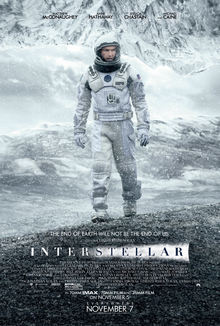
In some early reviews the new science fiction film 'Interstellar' has been compared to Stanley Kubrick's '2001- A Space Odyssey' which is not too far off. As in that 1968 film there are segments of this one that leave the viewer spellbound and often in wonderment (and mystery) at being enfolded in an almost metaphysical realm (especially one sequence where the astronaut 'Coop' finds himself inside a hyper-dimensional tesseract.)
The film, directed by Christopher Nolan, stars Matthew McConaughey, Anne Hathaway, Jessica Chastain, and Michael Caine. It is basically about a team of space travelers who travel through a wormhole in search of a new habitable planet. The opening scenes (roughly 20 minutes) show why. The Earth is now ravaged by monstrous dust storms and all its grain crops are dying out or have already become extinct because of a blight.
The scenes are realistic as we see people covered in dust, which gets into every nook and cranny, and also invades living spaces, smothers tables, linens, and incites chronic coughs. One of the most upsetting scenes occurs during a baseball game when a giant Haboob bears down and all the spectators must run for cover.
We don't know how the planet came to be this way or what caused the blight affecting the crops, but it doesn't take a lot of imagination to think that it has been spawned from radical climate change, at a time when even the seasons have stopped. The film cites the population being "9 billion" which would put the year at about 2040. (David Suzuki's projection for the first "year of no seasons" - marking the beginning of the runaway greenhouse effect).
Ultimately, the has-been astronaut Coop gets a new lease on his astronaut life when he ends up locating (using Morse code decoding of a gravimetric signal in his home) the only existing NASA facility. It is surrounded by barbed wire and kept ultra-secret, because as Prof. Brand (Michael Caine's character) tells him, you can't be spending billions on space ships when the world is starving and the only surviving grain crop is corn - which is also on its way out.
In this hidden enclave, Coop learns that 12 earlier "Lazarus" missions have been sent out - using a wormhole discovered near Saturn. Some have sent back signals indicating planets that might be able to support human life. These planets are all located in another galaxy, so clearly conventional rocket power would never be adequate to reach them. Thus has Coop been recruited to pilot Endurance, an experimental spacecraft, to follow the Lazarus Missions, through the wormhole to survey potential planets' long-term habitability. (By the time of Coop's launch the data from the Lazarus Mission has given NASA three potentially habitable planets: Miller, Edmunds, and Mann, named after the astronauts who carried out the surveys.)
The Endurance trek to the vicinity of Saturn alone takes two years, requiring all the astronauts to enter a hibernation condition to save oxygen. The wormhole itself is really a sphere, and by now the astronauts are awake as Coop enters through it - with incredible cgi graphics images depicting the transition.
The remainder of the film depicts astronauts Coop, Brand (Prof. Brand's daughter, played by Anne Hathaway) and Bromley trying their best to at least get to one more habitable world - after a disaster befalls them on Miller's planet (where one hour equals 7 years because of the gravitational slowing of time) and the craft is upended by a monstrous tidal wave some half- mile high, killing one of their original team.
A key segment, which I won't go into as it gives too much away, is the plan to pilot Endurance to a "gentle" black hole's ergosphere, jettison an AI designed robot into the event horizon and have it send data regarding the singularity within the black hole back to Earth.
What impressed me the most about the film is how realistically it depicted what an interstellar voyage would really be like, even assisted by a convenient wormhole and relativity. Bottom line: No picnic! Unlike most such portrayals of locating an alter-Earth (cf. the TV series 'Earth Two') there are no flora -abundant, hospitable planets, but mostly barren and hostile - with t he possible exception of "Edmund's planet". We understand from the get- go life will largely be a matter of survival not simply landing in 'paradise' in the midst of avocado and mango trees.
One other point: Some reviews, for example in The Financial Times, have complained about needing "a baccalaureate degree in astrophysics" to understand the scientific interjections "about once every fifteen minutes". But first, the references were not that frequent (more like once every half hour) and second, they were totally within the grasp of a reasonably scientifically literate person - say who has read Hawking's 'Brief History of Time' or similar works. Nor were any equations actually used in the explanations, we only see them occasionally when the blackboard is shown in Prof. Brand's (the elder's) office. All the equations are based on actual astrophysical theory and were pre-prepared by Kip Thorne of Caltech, one of the pre-eminent researchers of black holes and one of the film advisors.
By all means, if you have the chance to see this film, see it. It offers hope that one day, indeed, we may actually transfer the vision of settling other words to really doing so - as opposed to waiting for a monster, planet-killing asteroid (or something else) to take us out.
No comments:
Post a Comment